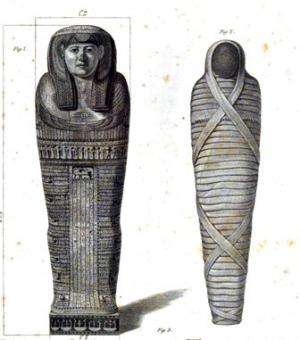New research unwraps the study of ancient Egypt

(Phys.org) —The study and popular perception of Egyptian antiquities focuses too much on the unwrapping of mummies and the use of technologies such as scanning, according to an academic from the University of East Anglia.
In a new book published today, Egyptologist and former museum curator Dr Christina Riggs challenges the scientific and medical approach that has become commonplace. Unwrapping Ancient Egypt sheds light on both the past and contemporary practices of collecting, displaying and presenting ancient Egypt – and especially Egyptian mummies – in museums and the media.
"Egyptian mummies may pull crowds, but focusing on them only as bodies means we overlook what was arguably much more important from an ancient Egyptian point of view: their wrappings," said Dr Riggs, a senior lecturer in the School of Art History and World Art Studies at UEA.
One issue Dr Riggs raises is the gulf between what wrappings and mummification meant in ancient Egypt, and the emphasis placed on analyzing the bodies today, as if scientific techniques are the only way to gain new insight on the past. In many museums that house Egyptian antiquities today, techniques such as endoscopy, CT scans, X-rays and facial reconstruction focus attention on the body beneath the original, careful arrangements of linen. In earlier times, mummies were also completely unwrapped and dissected.
"Research in the arts and humanities tries to understand the rich variety of social and cultural life over time - what makes us similar, for instance that all humans have bodies, but also what makes us different, because not every society thinks about the body in the same way," said Dr Riggs. "Applying medical research to Egyptian mummies focuses on their human-ness, as if a body tells us everything we need to know about a person, yet science is as much an interpretation as anything else. A body could be so much more, and what my research suggests is that wrapping techniques were absolutely essential to Egyptian mummification because the body was no longer human, but divine."
Hundreds of metres of textiles - always made of linen - went into wrapping mummies. The textiles often came from clothing the deceased had worn in life, plus cloth donated by family members or the local temple. Dr Riggs said: "Wrapping a mummy was a religious ritual, similar to the rituals priests performed every day in the temple, to wrap and dress the statues of the gods. Looking at the parallels between these rites helps us understand that to the Egyptians, a mummy wasn't so much a dead body, as a sacred object. And it needed to stay wrapped up."
Published by Bloomsbury, Unwrapping Ancient Egypt is the result of a five-year research project, partly funded by the Arts and Humanities Research Council. It breaks new ground by looking at the significance of textile wrappings in ancient Egypt, and at how their unwrapping has shaped the way we think about the Egyptian past. Dr Riggs draws on museum collections, ancient Egyptian art and writing, and century-old archaeological reports which record wrapped-up objects, including mummies, that were almost always unwrapped straight away. Often the textiles were not even saved, because they were considered too fragile or not interesting enough.
Dr Riggs points out that it is important to understand the long and in many ways controversial history of unwrapping and studying mummies. Academics and museums are only just starting to question how colonial-era assumptions, for instance about racial inequality, shaped research in Egyptology. In the 19th and early 20th centuries, medical doctors and archaeologists used ancient Egyptian mummies to help develop racial science. Many wanted to prove that the Egyptians were closer to Europeans than to African or Arab population groups, and although this approach is discredited today, it had a lasting impact.
"What I have found so surprising," said Dr Riggs, "is that we have been asking the same questions, for example about race and disease, for over 200 years. Reading a report from the 1820s or the 1920s, or websites and news articles today, I couldn't help but feel stuck in a rut, as if the only thing that had changed about research on Egyptian mummies was the technology we use, not the fundamental issues at stake."
More information: The first chapter of Unwrapping Ancient Egypt is available online: bloomsburycp3.codemantra.com/W … =9780857854988&sts=r
Provided by University of East Anglia




















